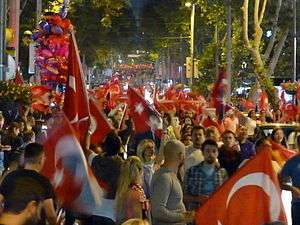Bağdat Avenue
| <span class="nickname" ">Bağdat Caddesi | |
|
Riders in Stage 8 of the 49th Presidential Cycling Tour of Turkey at Bağdat Avenue, 2013. | |
| Length | 14,000 m (46,000 ft) |
|---|---|
| Location | Maltepe-Kadıköy, Istanbul, Turkey |
| Postal code | 34846, 34842, 34840, 34744, 34740, 34738, 34730, 34728, 34724, 34722 |
| Coordinates | 40°57′12″N 29°05′43″E / 40.95344°N 29.09517°ECoordinates: 40°57′12″N 29°05′43″E / 40.95344°N 29.09517°E |
| From | Üsküdar Caddesi in Cevizli, Maltepe |
| To | Taşköprü Caddesi in Kızıltoprak, Kadıköy |
Bağdat Avenue (Turkish: Bağdat Caddesi, literally Baghdad Avenue) or simply Avenue (Turkish: Cadde) is a notable high street located on the Anatolian side of Istanbul, Turkey. The street runs approximately 14 km (8.7 mi) from east to west in the Maltepe and Kadıköy districts, almost parallel to the coastline of the Sea of Marmara. The most important part of the street is the one-way traffic, avenue-like section, which is 6 km (3.7 mi) long from Bostancı to Kızıltoprak, within the district of Kadıköy. It can be seen as the counterpart of Istiklal Avenue on the European side in terms of importance and glamour.
It is a main street in an upper-scale residential area. The one-way avenue with old plane trees is flanked with shopping malls, department stores, fashion garment stores, elegant shops offering world famous brands, restaurants of international and local cuisine, pubs and cafes, luxury car dealers and bank agencies. Bağdat Avenue can also be considered as a large open-air shopping mall. Most of the retail stores are open on all days of the week, including Sunday afternoon.
In summer time and on weekends, the sidewalks of the avenue are crowded with people window-shopping and youngsters lingering around. Traffic congestion is almost a standard situation on the three-lane Bağdat Avenue.
Since the 1960s street racing has been a sub-culture of the avenue, where young wealthy men tag-raced their imported muscle cars. Most of these young men are now middle-agers reliving their years of excitement as famous professional rally or track racers. With the heightened GTI and hot hatch culture starting in the 1990s, street-racing was revived in full. Towards the end of the 1990s, mid-night street racing caused many fatal accidents, which came to a minimum level thanks to intense police patrol.[1]
The neighbourhoods on the route westwards are: Cevizli, Maltepe, İdealtepe, Küçükyalı, Altıntepe, Bostancı, Çatalçeşme, Suadiye, Şaşkınbakkal, Erenköy, Caddebostan, Göztepe, Çiftehavuzlar, Selamiçeşme, Feneryolu and Kızıltoprak. The busiest and most crowded districts of Bağdat Avenue are located between Suadiye and Caddebostan (both inclusive), where most shopping malls and fashion stores are located.
The area around Bağdat Avenue has a variety of transportation alternatives in addition to the bus and taxi options. There are seabus (high-speed catamaran ferry) terminals in Kadıköy and Bostancı, and a regional rail running just north of the avenue, which serves the district. Bostancı also has a quay for the traditional commuter ferries, which provide connection with the European part of the city as well as the nearby Princes' Islands.
History
The origin of Bağdat Avenue was a road connecting Constantinople with Anatolia during the Byzantine and later the Ottoman periods, which was used for trade and military purposes. The road was named after Baghdad following the recapture of this city by Sultan Murad IV in 1638. However, the original road started from Üsküdar and passed through Haydarpaşa Meadows, joining the recent route in Kızıltoprak. The Ottomans built fountains with praying places along the road for travellers arriving to or departing from the city. Some of the neighbourhoods on Bağdat Avenue are still named after these fountains (Turkish: çeşme), such as Söğütlüçeşme (Willowed fountain), Selamiçeşme, and Çatalçeşme (Forked fountain).
During the reign of Sultan Abdul Hamid II (1876–1909), some Pashas, high officials and wealthy traders, who wanted to be as close as possible to the palace, purchased land plots around Bağdat Avenue and erected luxurious wooden chalet mansions, some of which still exist today.
Before World War I, the avenue was paved with cobblestone, and carriages were used for transportation. In the early years of the Republican era, the original cobblestone avenue was covered with asphalt, and a tram line was constructed between Kadıköy and Bostancı.
Until the 1960s, the area around Bağdat Avenue was used as a summer resort primarily for the city's wealthy and upper middle class, who lived actually on the European part of İstanbul because of their business. Following the opening of the Bosphorus Bridge in 1973, the lowrise summer houses were pulled down in order to build highrise condominiums and the district developed into one of the most desirable residential areas of the city.
Celebration avenue

Bağdat Avenue hosts a cultural parade on the evening of Republic Day, which is celebrated every year on October 29.
Bagdat Avenue can be considered as the celebration center of the Asian side. Just as Taksim is where people gather for huge national events on the European side, people on the Asian side gather on Bağdat Avenue to celebrate events such as a sport victory or a national holiday.
Another grand celebration takes place on Bağdat Avenue whenever the home football team Fenerbahçe SK wins the championship title in the Turkish Super League. Fenerbahçe fans gather in the avenue and celebrate carnival on it, while singing, dancing, driving and sounding their car horns all night.
Namesakes
In some other places around the world, Turkey included, there are streets of the same name:
See also
References
- ↑ Newspaper Sabah (Turkish)
- ↑ Municipality of Kayseri Archived January 12, 2007, at the Wayback Machine.
- ↑ Virtual Tourist
External links
| Wikimedia Commons has media related to Bağdat Caddesi. |
- Kadıköy Journal Homepage (Turkish)
- Bağdat Street Net (Turkish)
- Bağdat Caddesi 3D Virtual Tour (Turkish)